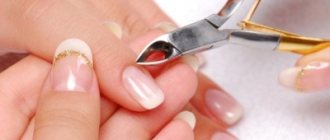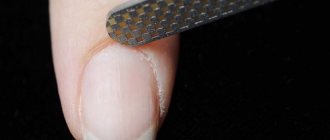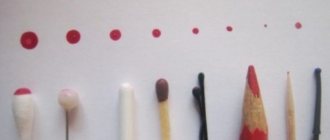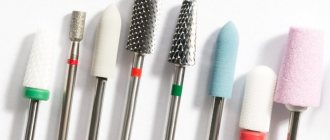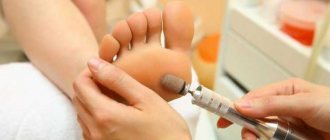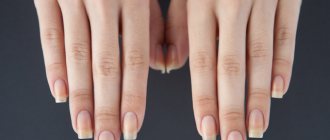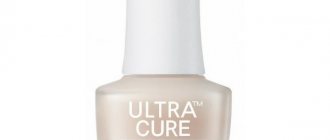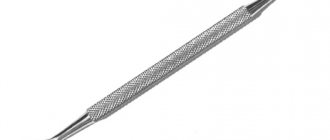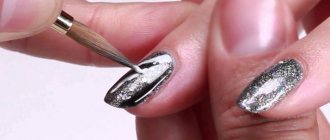The condition of the fingers after a cosmetic procedure directly depends on the quality of the manicure tools. With proper sterilization and pre-sterilization cleaning, the service becomes high-quality and safe. Sterilization of instruments can be carried out in various types of devices. The best option is an autoclave for manicure instruments and their subsequent storage before the procedure. Autoclaving at standard temperatures guarantees the sterility of manicure instruments.
What is an autoclave
A medical autoclave is a thermal sterilizer that processes instruments using steam supplied under pressure.
The temperature of the steam inside the chamber reaches 135 degrees. Used at the final stage of processing manicure instruments, after disinfection and pre-sterilization cleaning. It is a device approved for sterilization in accordance with SanPiN 2.1.2.2631-10. An autoclave for a nail salon is no different from an autoclave for a dental office - in both cases a medical autoclave is used. Take this into account when searching for a device.
How and with what to disinfect, sterilize and clean manicure instruments
Autoclaves are usually installed in salons with high customer traffic, where it is necessary to sterilize a large number of sets of instruments at the same time. Also, autoclaves are on average 2 times faster than dry-heat ovens, which further increases their efficiency.
Steam medical sterilizers can be equipped with two functions that influence the sterilization process:
- Vacuum drying is the removal of moisture particles from the surface of treated instruments resulting from sterilization with wet steam. Drying is possible thanks to the built-in vacuum pump, which turns on after the end of the process and allows you to remove an almost dry tool from the chamber. The humidity of the devices after drying does not exceed 3 percent;
- Pre-vacuum - The vacuum pump operates to remove excess air from the chamber before the sterilization procedure begins. Pre-evacuation of air helps hot steam reach all surfaces and kill bacteria and microorganisms.
Kraft bags are used as individual packaging - the same ones used for dry-heat processing. Special bags for the autoclave made of paper and film are also used - their use is allowed only for steam sterilization.
Based on the presence or absence of the listed functions, GOST R EN 13060-2011 “Small steam sterilizers” distinguishes three classes of autoclaves:
- Class B – with vacuum drying and preliminary vacuum . They are used in dentistry, surgery, cosmetology and beauty salons - wherever instruments have a complex shape and are sterilized only in individual packaging;
- Class S – with vacuum drying . It is possible to sterilize instruments both in packaging and without it;
- Class N – without additional functions . Sterilization is carried out without the use of individual packaging for instruments - the instrument is placed in a tray and used within 2 hours after treatment. Not suitable for devices of complex shape with recesses and sections, for example, milling cutters.
class N device for a nail salon or office , since instruments in sealed bags cannot be sterilized in such an autoclave.
#2 How much does an autoclave cost?
A professional autoclave is expensive. This equipment is usually massive. It is suitable for medium and large beauty salons and can sterilize several sets of instruments at a time.
A professional autoclave will cost the salon 80-100 thousand rubles, but this investment is really necessary. An autoclave is the first indicator of the class and level of a beauty salon. The device 100% removes germs and harmful pathogens, including the human immunodeficiency virus, fungal and herpes diseases, hepatitis B and C.
Sterilization time
The same GOST R EN 13060-2011 sets the time recommended for sterilization depending on the selected temperature:
- At a temperature of 121 degrees – sterilization time is 15 minutes;
- At a temperature of 126 degrees – 10 minutes;
- When set to 134 degrees – 3 minutes;
- Temperature 143 degrees – 1 minute.
In practice, the time period for sterilization varies significantly. In order to comply with all the rules and ensure high-quality processing of instruments, read the instructions for your autoclave.
UV sterilizer
Ultraviolet sterilizer is the most popular on the market. It gets rid of bacteria without having a negative impact on the environment. Not only instruments made of steel, but also those made of any other materials are sterilized inside it, since there is no exposure to high temperatures.
Cleansing is done using ultraviolet rays. In just 15 minutes you will receive sterile instruments and will not harm yourself - because it is safe.
Such devices have a modern design and are easy to fit into the interior of a salon or home. It has only one drawback - only those manicure accessories on which the rays fall are sterilized. But now there is a large selection of UV sterilizers that provide complete sanitation.
- Should you buy clothes online?
- 8 things you need to know before buying a house with a pool
- How to choose the right bed for the bedroom?
Peculiarities
Advantages:
- Short full cycle. The maximum operating time of the autoclave does not exceed 40 minutes. During this time, all bacteria, viruses and pathogenic microorganisms are destroyed. In terms of its effectiveness, an autoclave is identical to a dry heater, but sterilizes 2 times faster;
- Low power consumption;
- Large capacity of the internal chamber - from 2 to 50 liters;
- Doesn't dull the tool.
Flaws:
- High price. Unlike other types of sterilizers, an autoclave is much more expensive. For a high-quality device you will have to pay from 80 thousand rubles.
- Only distilled water is used for work. This is due to the fact that ordinary water contains many harmful impurities that can damage the sterilizer;
- High humidity, especially in devices without vacuum drying, causes corrosion on instruments.
The autoclave is the most reliable device for sterilization and allows you to kill almost all harmful microorganisms on the surface of the instrument.
Sukhozhar - types, choice, use of a sterilizer
Types of sterilizers: their advantages and disadvantages
The salon equipment market offers many options for sterilizers in different price segments. Disinfection methods for devices differ, which results in different costs and processing times. The price indicator is also influenced by the device’s capacity, case material and brand. How to deal with all this? Compare them and draw conclusions.
In order to process all the necessary tools efficiently, you need to pay attention to the following characteristics of the unit:
- Ease of use.
- The size of the chamber (box) for sterilizing instruments.
- Time to sterilize all supplies.
- Processing quality.
- Price.
Before using the device in the salon or at home, you should read the instructions for use. It is necessary to follow the rules for disinfecting instruments in advance before starting sterilization in the device. What are they and which one is better to choose? The questions are not simple.
When choosing a device in a store, you should pay attention to the following nuances:
- turn it on, check whether it works or not;
- availability of a product passport;
- terms of warranty service (so that repairs can be made if necessary).
You can find your ideal sterilizer; there are even types that have been approved by Sanpin.
Ball
Disinfect scissors, tweezers, files and other manicure/pedicure accessories in seconds, possibly with a ball sterilizer.
Ball type
Principle of operation. A filler is placed in the cup-shaped chamber - mini balls similar to sand. Additional name: quartz. By heating small balls to a temperature of 250⁰C, the device is ready to efficiently disinfect any metal surfaces.
Ease of use. Such devices are compact, quickly sterilized, and can be used both at home and in the salon. It is not the entire tool that is immersed, but only its working part without traces of moisture on the surface.
Duration of processing. It only takes about 20 seconds to sterilize a full container of instruments.
Processing quality. Absolute sterility of all accessories is achieved.
Price. Judging by the rest of the units, the cost is low.
Advantages. There is no possibility of damaging the instruments by constant processing.
Flaws. Unfortunately, there are enough of them.
- Possibility of processing tools only made of steel. Other materials are not suitable for processing.
- After turning on, you need to wait about half an hour for the device to heat the balls. Only then can disinfection begin.
- The filler must be replaced after a year of use.
- Balls dull the sharpness of tools.
Glasperlen
One of the types of ball sterilizers. Has similar disinfection conditions as the ball one. Glasperlene sterilizer has its pros and cons. To properly handle the balls, there are instructions that you should read before using the device.
Glasperlene sterilizer
Principle of operation. Glass balls (glasperlene) are heated to a high temperature of 250⁰C, killing all microorganisms on the surface of the instruments. The diameter of the balls is adjusted to the size of frequently sterilized instruments.
Ease of use. It is not necessary to store sterile instruments; they can be sterilized directly before the client. You need to use the Glasperlene sterilizer carefully to avoid getting burned.
Duration of processing. No more than 30 seconds (this is enough to completely process the products).
Processing quality. Devices with glasperlen are those that are officially approved by Sanpin, as they are capable of destroying the HIV virus. But does hepatitis kill? Yes, since the processing temperature is high.
Price. A relatively affordable option for use by craftsmen of different income levels.
Advantages. Optimal price-quality ratio. The best among other types sterilizes instruments, destroying all infections and viruses.
Flaws. The same as in the case of ball devices.
UV sterilizer
Does not guarantee complete sterility of items after processing. More often used to maintain sterility after more serious processing, even in medical institutions. More suitable for disinfecting items that do not carry the risk of transmitting dangerous diseases - makeup brushes, combs.
Principle of operation. A UV lamp emits rays that fall on the surface of the object and disinfect it.
Ease of use. Tools made of any material can be processed, and they do not deteriorate during the process. It is impossible to get a burn
Duration of processing. About 40 minutes.
Processing quality. Most bacteria are killed, but many viruses are resistant to UV radiation and remain on instruments.
Price. Quite low prices for devices make them popular, although they are not effective enough.
Advantages. Low cost, suitable for home use, can process both plastic and metal products.
Flaws. Not complete death of pathogenic microorganisms, duration of the cleansing process.
Ultrasonic
It is considered the highest quality unit for getting rid of bacteria and viruses of various types. To work, you need a familiar liquid substance - water. No solutions are required.
Uz-sterilizer
Principle of operation. Ultrasonic vibrations distribute the liquid in the tray over the instruments in the form of many bubbles, which seem to “massage” the objects, removing not only plaque from them, but also pathogenic microflora.
Ease of use. No particular inconveniences were found when using the unit.
Duration of processing. Up to 10 minutes.
Processing quality. All types of contaminants and pathogenic microorganisms are completely removed.
Price. Slightly higher than previous types.
Advantages. Professional unit for complete sterilization of instruments. It is possible to store tools inside the device.
Flaws. Relatively long processing time.
Other types
Thermal sterilizers are more common for complete disinfection of instruments. They influence the pathogenic environment with high temperatures, completely eliminating all microorganisms from objects. Pictures of them can be found on the Internet along with other types of devices.
Sukhozhar
A dry-heat cabinet resembles a stove in its operating principle: the dry air inside heats up to 250⁰C, so it is forbidden to sterilize non-metal objects in it. The disinfecting effect is achieved through heat treatment of instruments. The time for high-quality sterilization is from 1 hour.
Sukhozhar
Often devices have a cooling system. Why is she needed there? To start working with instruments immediately after they have been disinfected.
The cost of the dry heater is quite high and is not a profitable solution for craftsmen with low customer traffic. Even a small dry fryer requires careful handling to avoid burns. A detailed description of safety precautions should be read in the instructions.
Autoclave
An alternative to a fire oven is an autoclave. In a high-pressure chamber, the temperature rises to 134⁰C, which creates the condition for the death of microorganisms. The condition for sterilization is the careful placement of instruments in one row, although in the dry heat they can be placed in at least double portions. This does not affect the quality of processing. Operating time to achieve results is up to 20 minutes.
Autoclave
For home treatment of instruments (if there is no device), use the steam method (on the principle of a double boiler) and sterilization in the oven. But such measures do not guarantee proper care of the used instrument.
Kinds
Autoclaves differ from each other in technical characteristics, capacity and design.
There are 2 types of autoclaves based on loading type:
- Horizontal – equipped with a door and shelves inside the chamber. The number of shelves depends on the volume - from 1 to 7.
- Vertical – a round-shaped device with a box inside. Sometimes it is also equipped with a cassette holder - a lid with holes for sterilization cassettes made of plastic. The cassette itself is a plastic box with large holes where the tool is placed for further processing.
How to choose a sterilizer for manicure instruments
We have reviewed and studied basic information about all sterilizer options. But which one should you buy for a home or salon device?
The most popular are ultrasonic and UV devices, as they allow you to process absolutely any instruments, are compact and easy to use. But in terms of efficiency, dry heat and glasperlene options are recognized as the best. They treat instruments with high temperatures and destroy not only bacteria, but also viruses.
If the flow of clients is large, then the master uses a lot of tools. This means that the volume and size of the sterilizer are also important to consider when choosing a suitable model. There are those that can only hold one set, and there are those that can accommodate several at once. Moreover, it is important to take into account that the instruments to be cleaned cannot be placed on top of each other inside the sterilizer - they must be cleaned over the entire surface, without overlapping each other, otherwise there will be no proper result.
During sterilization, instruments must be neatly laid out inside the device.
The speed of disinfection usually depends on the power of the devices. The more powerful the device, the faster it cleans the surface being treated.
In short, when choosing a sterilizer, you need to consider the following parameters:
- desired level of cleaning of devices;
- cleaning speed;
- difficulty of use;
- power;
- duration of cleaning;
- dimensions;
- the material from which the tools used are made;
- budget;
- workmanship;
- manufacturer;
- customer flow.
These are the main parameters that are worth paying attention to. But design is a secondary point.
Another important parameter is the conditions in which the equipment will be used. So, for example, for a home studio you can take a modest sterilizer. And if we talk about a studio or beauty salon, then it is better to take several options of sterilizers at once and carry out the highest quality processing of instruments using several equipment options at once. In this case, it will be possible to achieve maximum sterility.
Additional functions
Depending on the manufacturer and model, the autoclave may have the following functions:
- Touch control;
- Possibility of connecting to a printer to print sterilization results or built-in printer;
- Built-in memory to save data about recent processes;
- Automatic diagnostics of problems, allowing the device to switch itself off when errors are detected;
- Port for connecting to a computer;
- Delayed cycle – setting a specific time to start processing.
Which autoclave is best to buy for sterilizing manicure instruments?
The choice of device model depends on the requirements of the salon and is based on the following criteria:
- Device class – selected from those described above based on the list of tools.
- Chamber volume: 2, 5, 12, 18 liters (there are autoclaves of other capacities) - chosen depending on the size of the cabin and the number of devices being processed simultaneously.
- Number of operating modes (adjustment of pressure, temperature and, accordingly, processing time).
- Built-in printer function - used to control sterilization, indicate the duration of the autoclave, date, etc. Necessary in large salons with a large number of working manicure sets.
- Brand, country of origin.
Attention! Nail service specialists claim that the savings on a sterilizer are imaginary and incommensurate with the harm that the lack of proper treatment will cause to the client and the nail technician.
Instructions
How to use an autoclave step by step:
- Carry out disinfection and pre-sterilization treatment;
- Check that there is enough water. Some models display the balance on the display, for example Euroklav 23V S from the Melag brand. If your device is not equipped with such a function, check the fluid manually;
- If necessary, fill the reservoir with water. It is important not to pour too much liquid. To determine the maximum water level, read the instructions for your autoclave;
- Place your tools in the camera. Place them in such a way that steam has access to all surfaces. Do not load devices on top of each other in several layers. If sterilization is carried out without the use of individual bags, place an indicator strip inside the tray to further determine the degree and quality of processing;
- Make sure that individual bags or loose instruments do not touch the walls of the autoclave;
- Close the door and set the temperature and time;
- Wait until the procedure is completed and immediately remove the instruments using tweezers;
- Check the indicators and package integrity, then turn off the device.
If the bags are damaged, the instrument inside them is considered not sterilized and must be reloaded.
Disinfection and pre-sterilization cleaning of manicure instruments: how to choose a disinfectant and prepare the solution correctly
Ultrasonic sterilizer or washer-sterilizer
No. 3 – Instrument sterilizer Sanitas SUR 42
This sterilizer is used not only for cleaning all kinds of instruments used in the beauty industry, but also for jewelry and dentures. In a word, it is suitable for everything that requires careful and attentive care, as well as compliance with all rules of sterility and safety.
The device has a small display and a timer showing operating time. Backlight - LCD. The reservoir has a volume of 550 ml. The power of the device is 50 W. The dimensions are quite compact and are 21*13*20 cm.
As buyers note, the device makes virtually no noise and looks beautiful. But, unfortunately, it is not always durable. However, its price is reasonable, and for a novice master or for use at home, this sterilizer is an excellent option.
pros
- low cost
- small sizes
- powerful
- beautiful appearance
- silent operation
Minuses
- not durable
Prices for Sanitas SUR 42 sterilizer
Sterilizer Sanitas SUR 42
Reviews of the Sanitas SUR 42 sterilizer
No. 2 – ruNail, ultrasonic device for instruments
A sterilizer that is suitable for manicurists, hairdressers, and for home use. The bowl is larger than the previous version, which means the device is capable of processing a larger number of items at once.
This device is used to treat instruments using ultrasonic waves, which have a high enough frequency to combat contaminants. For ease of use there is a timer and a small digital display. Power consumption - 35 W. The frequency of the ultrasound wave is 40 thousand Hz. The volume of the bowl is 750 ml. The dimensions are small - 20*17*15 cm. Moreover, the tool processing time is only 15 minutes. The weight is a little more than a kilogram, but the device is still easy to transport if necessary.
pros
- compact dimensions
- convenient use
- big bowl
- high frequency ultrasound wave
- quick cleaning
Minuses
- not detected
Prices for ruNail sterilizer
ruNail, ultrasonic device for instruments
No. 1 – Washer-sterilizer VGT-2000
This device copes well with dirt even in the most inaccessible places. He will complete the task assigned to him without any problems.
The device is used by nail technicians and hairdressers who work with metal tools. But it can also be used for processing jewelry, dentures, optical devices, and silverware. The sterilizer has a power of 35 W, a timer that shows how much time is left until the end of the procedure. The container is made of steel and is not afraid of corrosion. The ultrasonic frequency is 40 thousand Hz, and it is enough to cope with various contaminants. The container operates for 180 seconds and then turns off itself, but the operating time can be increased manually. Bowl volume - 600 ml.
pros
- Suitable for cleaning various items
- not afraid of corrosion
- high quality cleaning
- timer
- sufficient volumes
Minuses
- not detected
Prices for washer-sterilizer VGT-2000
Washer-sterilizer VGT-2000
Caring for the sterilizer
The autoclave does not require thorough cleaning and treatment, however, to maintain cleanliness it is recommended:
- Every day, wipe the door or lid rubber bands with a soft cloth soaked in a disinfectant solution;
- Once a week, wash the inner chamber with soapy water or a specialized product, such as Chamber Brite;
- At least once every seven days, check the condition of the air nozzle to ensure unhindered entry of the air stream into the chamber;
- Once a year, change the gasket on the door or lid to maintain a tight seal;
When cleaning the autoclave chamber, it is strictly forbidden to use:
- Metal jaws;
- Bleach.
Operating principle of a manicure autoclave
A sterilizer for manicure instruments or an autoclave is a device that disinfects the surface of devices used by a nail technician during the work process.
Caring for tools in nail studios and those who provide services at home is carried out strictly according to certain rules in the established sequence. First, scissors, files, buffs, and spatulas are immersed in a disinfectant solution for the time specified in the instructions. Afterwards, the manicure tools are taken out and washed under running water. The final stage is sterilization and drying. At this stage, the microorganisms remaining after the first two steps are removed from the surface of the nail devices. Only this sequence guarantees cleanliness and sterility, which ensures that there is no risk of contracting viral, bacterial, or fungal infections.
Sterilization is carried out in one of three types of devices:
- glasperlene;
- dry heat cabinet;
- autoclave.
The first of the listed devices dulls the tool and is not suitable for all types of manicure devices. Dry heat is more versatile, but it consumes a large amount of electricity, sterilization takes a lot of time, and the metal parts of the instruments darken. An autoclave is considered the best option.
The operating principle of the device is a combination of high temperatures and pressure, which ensures the disinfection of nail scissors, files, spatulas, and wire cutters.
Precautionary measures
Safety precautions when working with an autoclave:
- Make sure that the tool you put into the autoclave can withstand high temperatures. For example, a plastic pusher that melts during processing will cause significant damage to the device and cast doubt on the possibility of its use;
- When removing instruments after sterilization, use heat-resistant gloves or special tweezers;
- At the end of the cycle, open the door or lid slowly so that the hot steam leaves the chamber gradually;
- If problems are detected, for example, unusual noise, do not turn on the autoclave to avoid its final breakdown;
- Do not open the door while the cycle is running. Inside the chamber during processing, high pressure and interference with the sterilization procedure will harm not only the device, but also human health.
Workplace of a manicurist: requirements for design and equipment, SanPiN
Ultraviolet sterilizer
No. 3 – JessNail Sterilizer JN-9007
This sterilizer is one of the most practical and user-friendly models among UV sterilizers. It is used for the last stage of tool processing. That is, before placing them in this box, you need to hold them in special solutions or process them in dry heat.
Ultraviolet rays have a bactericidal effect and protect instruments from microorganisms. Thus, by storing instruments inside, you don’t have to worry about their sterility. The device power is 8 W, works from the network. Compact dimensions - 44*34*19 cm. The disinfection process lasts approximately 40 minutes.
The device is unpretentious in operation, convenient to use, but collects quite a few reviews on the Internet. However, there are very few openly negative ones.
pros
- small sizes
- sufficient power
- comfortable in using
- Suitable for various instruments
- reliable
Minuses
- not found
Prices for JessNail Sterilizer JN-9007
JessNail Sterilizer JN-9007
No. 2 – Germix TNL
This sterilizer is chosen by many manicurists for its unpretentiousness and low cost. Recommended for purchase in pedicure and manicure salons, as well as for hairdressers and hairdressers working at home. It is used to store already processed tools.
A 9 W lamp with bactericidal properties is installed inside the device. It is due to this that the disinfection of instruments occurs: that is, previously processed items will not be contaminated during storage until a new client arrives. Thus, at any time, the tools are ready to work with a person.
You can store instruments inside the sterilizer for up to a week. The equipment has appropriate safety certificates. The lamp does not emit ozone, and it also has an auto-shut-off function as soon as the chamber is opened - this helps protect the technician’s eyes.
pros
- small sizes
- low cost
- convenient use
- does not emit ozone
- Automatic lamp shutdown when opening the lid
- beautiful view
Minuses
- used for storing cleaned instruments rather than for processing them
Reviews of the Germix TNL sterilizer
No. 1 - Sunuv S2
This rectangular sterilizer is an indispensable assistant for nail technicians and hairdressers. Small, reliable and efficient, it deserves to be in every professional's possession. In just 3 minutes, this small box destroys almost 100% of microorganisms, over the entire surface of the instruments placed in it.
The device is used for disinfecting and processing various metal tools, and is also used for storing them. The box is absolutely sterile and allows you to protect any materials and objects contained in it from microorganisms.
Inside the sterilizer there are 8 powerful diodes of 8 W each. There is also a mirror bottom, a built-in battery, and a light filter to protect the master from UV rays. The silicone stand prevents the device from sliding.
As buyers note, the device is convenient to use and easy to transport if necessary. Cleaning up dirt is also not difficult. Weight - only 410 g.
pros
- convenient to transport
- it's inexpensive
- energy saving function
- 8 diodes 8 W each
- built-in battery
- silicone stand
Minuses
- not detected
Prices for the Sunuv S2 sterilizer
Sterilizer Sunuv S2
What to look for when purchasing
An autoclave is an expensive sterilizer, so when purchasing it you need to pay attention to all the details. When choosing a device, pay attention to:
- Chamber volume . This is especially important for large salons, where sterilization of a large number of instruments is required at the same time;
- Appearance . Relevant for craftsmen who do not have a separate processing room, where even sterilization equipment should look aesthetically pleasing;
- Guarantee . It is important that the autoclave has a warranty of at least 12 months. This will protect you in case of factory defects, defects, or non-compliance of the device with the stated characteristics;
- Repair and service . Make sure that the manufacturer or its representative offers warranty and post-warranty service or has up-to-date contact information for repairers. In the event of a breakdown, finding a repairman will not be easy;
- Ease of Management . Thanks to the huge selection, craftsmen purchase autoclaves with intuitive controls, which allows them not to study the instructions every time trying to figure out the next inscription on the display. Choose an easy-to-use autoclave;
- Accompanying documents . According to the requirements of SanPin 2.1.2.2631-10, the autoclave must have instructions in Russian and a document confirming the safety of its use. In addition, the device is accompanied by a certificate of conformity.
Rating of medical autoclaves for beauty salons
What to look for when purchasing an autoclave
To choose the right autoclave, you need to clearly understand what functions it will be intended for. In large salons with a constant flow of clients, autoclaves with a large chamber volume are required. For storing instruments and additional devices, autoclaves are equipped with additional temperature conditions and functions.
For small manicure salons or home use, portable autoclaves with overall dimensions that do not exceed forty-five centimeters along the front are suitable.
When purchasing, it is important to clarify the degree of thermal insulation of the case and where the device can be placed in the room. It should be remembered that the instruments are placed in a thin layer in the autoclave.
On the modern market there are automatic autoclaves in which the sterilization program is carried out using a built-in computer. You just need to load the manicure tools and select a function on the display. However, the price of such devices increases significantly.
Ultrasonic
The ultrasonic sterilizer is suitable for manicure and hairdressing instruments, as well as jewelry. An ultrasonic wave passes through the solution in the container, increasing the dielectric pressure, which creates microvacuum bubbles. Their decay cleanses the object of dirt, rust, harmful bacteria and microorganisms. At the same time, it does not damage even ceramic, plastic and glass instruments.
The ultrasonic sterilizer is used according to the following instructions:
- The items to be processed are placed in a container.
- It is filled two-thirds with disinfectant.
- The device is connected to the network and the sterilization time is set on the timer (up to 10 minutes).
- Turn on the device.
The sterilizer turns off automatically. If necessary, the stand inside the container is removed and washed. The processed instruments are stored in it. To more completely remove bacteria in cosmetology, this method is combined with subsequent heat treatment.
What are instrument sterilizers?
Sterilizers are convenient, small and compact devices that effectively clean cuticles and ensure safe customer service. In beauty salons, equipment is a necessity.
The devices are used to disinfect and sterilize manicure instruments from harmful microorganisms, which completely eliminates the risk of developing diseases during the provision of services.
Typically, the sterilization compartment is made of metal, and the outer housing is made of high-quality plastic. The material used does not require special care or expensive maintenance. For these reasons, the equipment is in demand by specialists in hairdressing salons, salons and establishments providing cosmetology services.
Methods for processing manicure tools
Sterilize with disinfectants and equipment with a physical and/or chemical disinfection mechanism.
Types of devices:
- for primary disinfection or PSO - ultrasonic baths/washes;
- for sterilization - autoclaves, dry heaters, boilers;
- for storage - bactericidal boxes, ultraviolet sterilizers.
Chemical treatment is done with disinfectants.
Boiling
The method is suitable for heat-resistant hand and hardware manicure items.
Rating of equipment for sterilization by boiling method:
- automatic electric boiler “KDEA 1-4”;
- disinfection electric boiler “E-40-1”;
- disinfection boiler “P-22-1” (for boiling on an electric stove).
Heat treatment is done after primary disinfection, PSO.
Sterilization algorithm:
- Clean items are placed in a boiler container with water.
- Waiting for it to boil.
- Boil for 20 minutes.
- The products are taken out with tongs and dried on sterile napkins.
It is advisable to boil in a 2% aqueous solution of “Sodium bicarbonate”. It increases the boiling point, improving the quality of sterilization.
Autoclave
Sterilization occurs under hot steam pressure with a temperature above +110 ºC. For manicure instruments, buy medical autoclaves of class B or S.
Cost of popular tabletop autoclaves:
- Prestige Medical Classic 2100, 9 l (Gehwol) - 63,500 rubles;
- TANZO C12, 12 l (Woson) - 100,000 rubles;
- STE-8, 8 l (IcanClave) - 103700.
The autoclave is used after primary disinfection, PSO. Disinfect objects that are resistant to hot steam.
Instructions for sterilizing manicure instruments:
- Water is poured into the autoclave, items are loaded, and sterilization indicator strips are laid out.
- They set the temperature and time and turn on the device.
- After processing, the products are transferred to a sterile place.
Manicure instruments are disinfected for 3–15 minutes. The exact duration of sterilization is indicated in the autoclave instructions.
Prestige Medical Classic
Dry heat cabinet
Manicure instruments in a dry heat are disinfected with air heated to a temperature of 180–200 ºC. Houses are treated with household sterilizers or in the oven.
For commercial purposes, dry heaters with Roszdravnadzor registration are used.
Rating of dry heaters for sterilization in the beauty industry:
- TAU Steril 2000 Automatic;
- "GP-20-3";
- "GP-10 MO".
Cabinets are used after primary disinfection, PSO. Manicure tools are placed in craft bags (for sterilization and subsequent storage), then placed in a heated dry heat.
TAU Steril 2000 Automatic
Glasperlene sterilizer
A glassperlene (aka ball) sterilizer disinfects at a temperature of +180–250 ºC in a container with small balls. Processes only the working surfaces of the tool.
Quartz beads must be replaced monthly, otherwise the quality of sterilization will decrease.
Disinfected in a Glasperlene sterilizer after disinfection, PSO, drying. The instrument is immersed in the heated balls for 20 seconds.
UV and ultrasound
Ultrasonic wash/bath/box - equipment for disinfection and PSO. Disinfects + cleanses using ultrasonic waves. Ultrasonic washers 1200 JP BYU, Eurosonic Micro, Dibea DADI DA-968 are popular.
Features of the use of ultrasonic washers:
- Disinfectant solution is poured into the container.
- Immerse used manicure tools.
- The sink is turned on.
- Afterwards, the product is washed under the tap, dried, and sterilized.
Manicure instruments are stored in ultraviolet boxes after sterilization without Kraft bags. The bactericidal environment in the device is maintained by UV lamps. The rating includes IRISK ZLP-C002, Planet Nails MiniGer, Germix two-chamber, FMX 898-8.
Kraft bags
The bags are used at the sterilization stage.
Products are available for use:
- in dry heat (heat-resistant);
- in autoclaves (do not get wet from steam);
- universal purpose.
The rating included craft packages “Steril” and “PSPV-Sterimag” from Medtest. Products with self-adhesive tape are suitable for autoclaves and dry heaters.
Application of kraft bag:
- Fill out the form on the front side.
- After PSO, the dry manicure instrument is loosely placed inside and sealed.
- The Kraft bag is placed in a dry heat/autoclave.
- To control sterilization, class 4 indicator strips are laid out in the chamber.
- Turn on the device.
After sterilization, the packages are not opened. The instrument is stored inside for 3–60 days, depending on the sealing method.
To watch the video:
Disinfection in solutions
Manicure products are disinfected with disinfectants containing surfactants, HOURS, triamine, guanidine, alcohol and/or an oxygen-containing substance.
Disinfectant solutions can be used step by step:
- primary disinfection (1st stage of disinfection);
- pre-sterilization cleaning;
- sterilization (if the material of the manicure product deteriorates due to high temperature or steam).
Disinfect with a ready-made product or a working solution prepared from a concentrate.
How to use the disinfectant:
- Liquid disinfectant is poured into the tray.
- Immediately after use, the manicure product is immersed in a disinfectant solution. The liquid should cover objects by 1–2 cm.
- After disinfection, the products are washed under the tap and dried. The exposure time is indicated in the disinfectant instructions.
After primary disinfection and PSO, sterilization is performed with equipment or a concentrated disinfectant solution.
See what mistakes it is better to avoid when processing:
